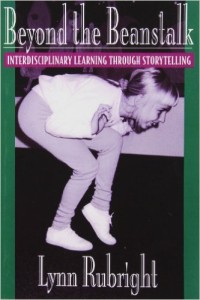 I found myself exclaiming, “Hey, neat!” at about every other page while I was reading Beyond the Beanstalk. Lynn Rubright, an educator and storyteller, developed the ideas and program suggestions for this book mostly while she was engaged in Project TELL (Teaching English through Living Language), a three year program funded by an American government grant. Her target audience is teachers of children, but so many of her ideas could be used by anyone who has an interest in telling stories — parents, grandparents, aunts and uncles, librarians, pastors, bards….
I found myself exclaiming, “Hey, neat!” at about every other page while I was reading Beyond the Beanstalk. Lynn Rubright, an educator and storyteller, developed the ideas and program suggestions for this book mostly while she was engaged in Project TELL (Teaching English through Living Language), a three year program funded by an American government grant. Her target audience is teachers of children, but so many of her ideas could be used by anyone who has an interest in telling stories — parents, grandparents, aunts and uncles, librarians, pastors, bards….
Rubright is convinced — and she’ll convince you if you read her book — that children’s imaginations are fired by hearing stories and participating in the storytelling themselves. When their imaginations are engaged, every kind of learning is enhanced, from writing to music to math, because they are discovering how to think creatively. Not only that, but sharing stories can draw different age groups and generations together to learn from one another in life-changing ways.
In a series of fourteen chapters, Rubright gives examples of different units or programs she conducted with different age groups, using different stories and different techniques for telling them. For example, in Chapter Nine she describes how she developed an Anansi the Spider story for a group of third through eighth graders, incorporating traditional African storytelling techniques and African dance. Later, the students would go on to write their own versions of Anansi stories, find Ashanti value proverbs related to the Anansi story cycle, and explore Ashanti textiles and art.
In Chapter Twelve, Rubright describes Eldertel, a program in which children and senior citizens meet and share stories, songs and dances with one another. In Chapter Fourteen, she shows how “artist in residence” programs in schools can be expanded to include poets and storytellers, who can work with children of different age groups on all sorts of different projects, from group storytelling and poem creation to writing plays.
Chapter Fifteen includes a list of good stories to begin with, including “Jack and the Beanstalk,” “Bellerophon and Pegasus” (a Greek myth), some “Anansi the Spider” tales and “The Man Who Tried To Change His Luck” (a traditional tale). In this chapter Rubright also explains her “quick and easy” method for a storyteller to learn and memorize stories to tell aloud — a method which also works well for children when creating and telling stories of their own. Rubright also includes three Appendices of useful information, such as how to incorporate storytelling into math and sciences curricula, how to teach and use movement to enhance the storytelling experience, and how to make simple books to contain children’s stories.
(Heinemann, 1996)
